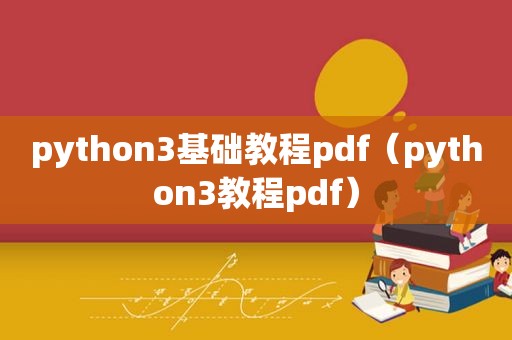本
文
摘
要

简介
Python作为一个开源的优秀语言,随着它在数据分析和机器学习方面的优势,已经得到越来越多人的喜爱。据说小学生都要开始学Python了。
Python的优秀之处在于可以安装很多非常强大的lib库,从而进行非常强大的科学计算。
讲真,这么优秀的语言,有没有什么办法可以快速的进行学习呢?
有的,本文就是python3的基础秘籍,看了这本秘籍python3的核心思想就掌握了,文末还有PDF下载链接哦,欢迎大家下载。
Python的主要数据类型
python中所有的值都可以被看做是一个对象Object。每一个对象都有一个类型。
下面是三种最最常用的类型:
Integers (int)整数类型,比如: -2, -1, 0, 1, 2, 3, 4, 5
Floating-point numbers (float)浮点类型,比如:-1.25, -1.0, –0.5, 0.0, 0.5, 1.0, 1.25
Strings字符串类型,比如:“www.flydean.com”
注意,字符串是不可变的,如果我们使用replace() 或者 join() 方法,则会创建新的字符串。除此之外,还有三种类型,分别是列表,字典和元组。
列表列表用方括号表示: a_list = [2, 3, 7, None]
元组元组用圆括号表示: tup=(1,2,3) 或者直接用逗号表示:tup=1,2,3
Python中的String操作
python中String有三种创建方式,分别可以用单引号,双引号和三引号来表示。
基本操作
my_string = “Let’s Learn Python!” another_string = ‘It may seem difficult first, but you can do it!’ a_long_string = ‘’‘Yes, you can even master multi-line strings that cover more than one line with some practice’’’也可以使用print来输出:
print(“Let’s print out a string!”)String连接
String可以使用加号进行连接。
string_one = “I’m reading “ string_two = “a new great book!” string_three = string_one + string_two注意,加号连接不能连接两种不同的类型,比如String + integer,如果你这样做的话,会报下面的错误:TypeError: Can’t convert ‘int’ object to str implicitlyString复制
String可以使用 * 来进行复制操作:
‘Alice’ * 5 ‘AliceAliceAliceAliceAlice’或者直接使用print:
print(“Alice” * 5)Math操作
我们看下python中的数学操作符:
操作符含义举例内置函数
我们前面已经学过了python中内置的函数print(),接下来我们再看其他的几个常用的内置函数:
Input() Functioninput用来接收用户输入,所有的输入都是以string形式进行存储:
name = input(“Hi! What’s your name? “) print(“Nice to meet you “ + name + “!”) age = input(“How old are you “) print(“So, you are already “ + str(age) + “ years old, “ + name + “!”)运行结果如下:
Hi! What’s your name? “Jim” Nice to meet you, Jim! How old are you? 25 So, you are already 25 years old, Jim!len() Functionlen()用来表示字符串,列表,元组和字典的长度。
举个例子:
# testing len() str1 = “Hope you are enjoying our tutorial!” print(“The length of the string is :”, len(str1))输出:
The length of the string is: 35filter()filter从可遍历的对象,比如列表,元组和字典中过滤对应的元素:
ages = [5, 12, 17, 18, 24, 32] def myFunc(x): if x < 18: return False else: return True *** s = filter(myFunc, ages) for x in *** s: print(x)函数Function
python中,函数可以看做是用来执行特定功能的一段代码。
我们使用def来定义函数:
def add_numbers(x, y, z): a= x + y b= x + z c= y + z print(a, b, c) add_numbers(1, 2, 3)注意,函数的内容要以空格或者tab来进行分隔。传递参数
函数可以传递参数,并可以通过通过命名参数赋值来传递参数:
# Define function with parameters def product_info(productname, dollars): print("productname: " + productname) print("Price " + str(dollars)) # Call function with parameters assigned as above product_info("White T-shirt", 15) # Call function with keyword arguments product_info(productname="jeans", dollars=45)列表
列表用来表示有顺序的数据 *** 。和String不同的是,List是可变的。
看一个list的例子:
my_list = [1, 2, 3] my_list2 = [“a”, “b”, “c”] my_list3 = [“4”, d, “book”, 5]除此之外,还可以使用list() 来对元组进行转换:
alpha_list = list((“1”, “2”, “3”)) print(alpha_list)添加元素
我们使用append() 来添加元素:
beta_list = [“apple”, “banana”, “orange”] beta_list.append(“grape”) print(beta_list)或者使用insert() 来在特定的index添加元素:
beta_list = [“apple”, “banana”, “orange”] beta_list.insert(“2 grape”) print(beta_list)从list中删除元素
我们使用remove() 来删除元素
beta_list = [“apple”, “banana”, “orange”] beta_list.remove(“apple”) print(beta_list)或者使用pop() 来删除最后的元素:
beta_list = [“apple”, “banana”, “orange”] beta_list.pop() print(beta_list)或者使用del 来删除具体的元素:
beta_list = [“apple”, “banana”, “orange”] del beta_list [1] print(beta_list)合并list
我们可以使用+来合并两个list:
my_list = [1, 2, 3] my_list2 = [“a”, “b”, “c”] combo_list = my_list + my_list2 combo_list [1, 2, 3, ‘a’, ‘b’, ‘c’]创建嵌套的list
我们还可以在list中创建list:
my_nested_list = [my_list, my_list2] my_nested_list [[1, 2, 3], [‘a’, ‘b’, ‘c’]]list排序
我们使用sort()来进行list排序:
alpha_list = [34, 23, 67, 100, 88, 2] alpha_list.sort() alpha_list [2, 23, 34, 67, 88, 100]list切片
我们使用[x:y]来进行list切片:
alpha_list[0:4] [2, 23, 34, 67]修改list的值
我们可以通过index来改变list的值:
beta_list = [“apple”, “banana”, “orange”] beta_list[1] = “pear” print(beta_list)输出:
[‘apple’, ‘pear’, ‘cherry’]list遍历
我们使用for loop 来进行list的遍历:
for x in range(1,4): beta_list += [‘fruit’] print(beta_list)list拷贝
可以使用copy() 来进行list的拷贝:
beta_list = [“apple”, “banana”, “orange”] beta_list = beta_list.copy() print(beta_list)或者使用list()来拷贝:
beta_list = [“apple”, “banana”, “orange”] beta_list = list (beta_list) print(beta_list)list高级操作
list还可以进行一些高级操作:
list_variable = [x for x in iterable] number_list = [x ** 2 for x in range(10) if x % 2 == 0] print(number_list)元组
元组的英文名叫Tuples,和list不同的是,元组是不能被修改的。并且元组的速度会比list要快。
看下怎么创建元组:
my_tuple = (1, 2, 3, 4, 5) my_tuple[0:3] (1, 2, 3)元组切片
numbers = (0, 1, 2, 3, 4, 5, 6, 7, 8, 9, 10, 11, 12) print(numbers[1:11:2])输出:
(1,3,5,7,9)元组转为list
可以使用list和tuple进行相互转换:
x = (“apple”, “orange”, “pear”) y = list(x) y[1] = “grape” x = tuple(y) print(x)字典
字典是一个key-value的 *** 。
在python中key可以是String,Boolean或者integer类型:
Customer 1= {‘username’: ‘john-sea’, ‘online’: false, ‘friends’:100}创建字典
下面是两种创建空字典的方式:
new_dict = {} other_dict= dict()或者像下面这样来初始赋值:
new_dict = { “brand”: “Honda”, “model”: “Civic”, “year”: 1995 } print(new_dict)访问字典的元素
我们这样访问字典:
x = new_dict[“brand”]或者使用dict.keys(),dict.values(),dict.items()来获取要访问的元素。
修改字典的元素
我们可以这样修改字典的元素:
#Change the “year” to 2020: new_dict= { “brand”: “Honda”, “model”: “Civic”, “year”: 1995 } new_dict[“year”] = 2020遍历字典
看下怎么遍历字典:
#print all key names in the dictionary for x in new_dict: print(x) #print all values in the dictionary for x in new_dict: print(new_dict[x]) #loop through both keys and values for x, y in my_dict.items(): print(x, y)if语句
和其他的语言一样,python也支持基本的逻辑判断语句:
Equals: a == bNot Equals: a != bLess than: a < bLess than or equal to a <= bGreater than: a > bGreater than or equal to: a >= b看下在python中if语句是怎么使用的:
if 5 > 1: print(“That’s True!”)if语句还可以嵌套:
x = 35 if x > 20: print(“Above twenty,”) if x > 30: print(“and also above 30!”)elif:
a = 45 b = 45 if b > a: print(“b is greater than a”) elif a == b: print(“a and b are equal”)if else:
if age < 4: ticket_price = 0 elif age < 18: ticket_price = 10 else: ticket_price = 15if not:
new_list = [1, 2, 3, 4] x = 10 if x not in new_list: print(“’x’ isn’t on the list, so this is True!”)Pass:
a = 33 b = 200 if b > a: passPython循环
python支持两种类型的循环,for和while
for循环
for x in “apple”: print(x)for可以遍历list, tuple,dictionary,string等等。
while循环
#print as long as x is less than 8 i =1 while i< 8: print(x) i += 1break loop
i =1 while i < 8: print(i) if i == 4: break i += 1Class
Python作为一个面向对象的编程语言,几乎所有的元素都可以看做是一个对象。对象可以看做是Class的实例。
接下来我们来看一下class的基本操作。
创建class
class TestClass: z =5上面的例子我们定义了一个class,并且指定了它的一个属性z。
创建Object
p1 = TestClass() print(p1.x)还可以给class分配不同的属性和方法:
class car(object): “””docstring””” def __init__(self, color, doors, tires): “””Constructor””” self.color = color self.doors = doors self.tires = tires def brake(self): “”” Stop the car “”” return “Braking” def drive(self): “”” Drive the car “”” return “I’m driving!”创建子类
每一个class都可以子类化
class Car(Vehicle): “”” The Car class “”” def brake(self): “”” Override brake method “”” return “The car class is breaking slowly!” if __name__ == “__main__”: car = Car(“yellow”, 2, 4, “car”) car.brake() ‘The car class is breaking slowly!’ car.drive() “I’m driving a yellow car!”异常
python有内置的异常处理机制,用来处理程序中的异常信息。
内置异常类型
AttributeError — 属性引用和赋值异常IOError — IO异常ImportError — import异常IndexError — index超出范围KeyError — 字典中的key不存在KeyboardInterrupt — Control-C 或者 Delete时,报的异常NameError — 找不到 local 或者 global 的nameOSError — 系统相关的错误SyntaxError — 解释器异常TypeError — 类型操作错误ValueError — 内置操作参数类型正确,但是value不对。ZeroDivisionError — 除0错误异常处理
使用try,catch来处理异常:
my_dict = {“a”:1, “b”:2, “c”:3} try: value = my_dict[“d”] except KeyError: print(“That key does not exist!”)处理多个异常:
my_dict = {“a”:1, “b”:2, “c”:3} try: value = my_dict[“d”] except IndexError: print(“This index does not exist!”) except KeyError: print(“This key is not in the dictionary!”) except: print(“Some other problem happened!”)try/except else:
my_dict = {“a”:1, “b”:2, “c”:3} try: value = my_dict[“a”] except KeyError: print(“A KeyError occurred!”) else: print(“No error occurred!”)最后附上Python3秘籍的PDF版本: python3-cheatsheet.pdf本文已收录于 http://www.flydean.com/python3-cheatsheet/
最通俗的解读,最深刻的干货,最简洁的教程,众多你不知道的小技巧等你来发现!

